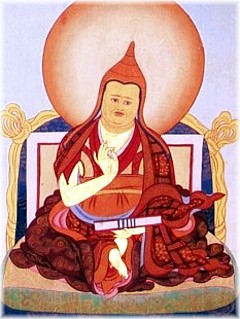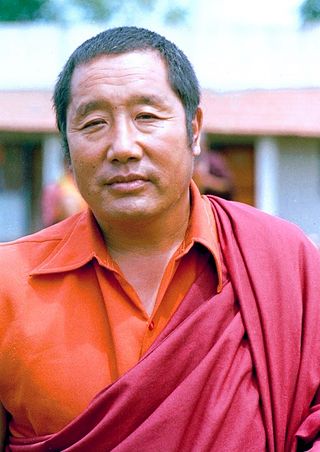Rongzom Chökyi Zangpo (Tibetan : རོང་ཟོམ་ཆོས་ཀྱི་བཟང་པོ, Wylie : rong zom chos kyi bzang po), [1] widely known as Rongzom Mahapandita, Rongzom Dharmabhadra, or simply as Rongzompa, was one of the most important scholars of the Nyingma school of Tibetan Buddhism. Together with Longchenpa and Ju Mipham, he is often considered to be one of the three "omniscient" writers of the school. His elder contemporary Atiśa (980–1054) considered Rongzompa to be an incarnation of the Indian ācārya Kṛṣṇapāda, the Great. [2] [3] The Tibetan historian Gö Lotsawa (1392–1481) said of Rongzom that no scholar in Tibet was his equal.
A.W. Barber writes that Rongzom was the first to receive the entire Dzogchen teachings of both Vimalamitra and Vairotsana after the time of those two masters. [4] According to the Blue Annals, Rongzom Chokyi Zangpo ... received the Semde (sems sde) teachings of the Dorje Dudjom transmission line. [5]
David Germano writes "In the eleventh century, Rongzom Chokyi Zangpo was without doubt the greatest Nyingma author, with extensive exoteric and esoteric commentaries." [6]
Rongzom held that the views of sutra such as Madhyamaka were inferior to that of tantra, as Koppl notes:
By now we have seen that Rongzom regards the views of the Sutrayana as inferior to those of Mantra, and he underscores his commitment to the purity of all phenomena by criticizing the Madhyamaka objectification of the authentic relative truth. [7]
According to a catalog of the commentaries he codified, the collected works of Rongzompa amounted to over 100 volumes, the majority of which are no longer extant. In the 19th century, Ju Mipham, who was particularly influenced by Rongzompa's writings, [8] attempted to gather the surviving works together.
Important surviving works of Rongzom Chokyi Zangpo include:
{{cite thesis}}: CS1 maint: multiple names: authors list (link){{cite journal}}: Cite journal requires |journal= (help)
Nyingma, often referred to as Ngangyur, is the oldest of the four major schools of Tibetan Buddhism. The Nyingma school is founded on the first lineages and translations of Buddhist scriptures from Sanskrit into Tibetan in the eighth century, during the reign of King Trisong Detsen.

Jamgön Ju Mipham Gyatso, or Mipham Jamyang Namgyal Gyamtso (1846–1912) was a very influential philosopher and polymath of the Nyingma school of Tibetan Buddhism. He wrote over 32 volumes on topics such as painting, poetics, sculpture, alchemy, medicine, logic, philosophy and tantra. Mipham's works are still central to the scholastic curriculum in Nyingma monasteries today. Mipham is also considered one of the leading figures in the Rimé (non-sectarian) movement in Tibet.

Kyabje Dudjom Jigdral Yeshe Dorje was known as Terchen Drodül Lingpa and as Dudjom Rinpoche. He is considered by many Tibetan Buddhists to be from a line of important Tulku lineage, and a renowned Tertön. Per lineage, he was a direct incarnation of both Padmasambhava and Dudjom Lingpa (1835–1904). He was a Nyingma householder, yogi, and a Vajrayana and Dzogchen master. According to his disciple Khenpo Tsewang Dongyal, he was revered as "His Holiness" and as a "Master of Masters".
The Guhyagarbha Tantra is the most important Buddhist tantra of the Mahayoga class and the primary tantric text studied in the Nyingma tradition. It is the main Nyingma source for understanding empowerment, samaya, mantras, mandalas and other Vajrayana topics, and has influenced the Dzogchen tradition. The Nyingma scholar Longchenpa sees it as "the highest summit of all vehicles, the source of all verbal transmissions, the great great shortcut of the vehicle of all Buddhas of the three times, the most secret."

Pema Lingpa or Padma Lingpa was a Bhutanese saint and siddha of the Nyingma school of Tibetan Buddhism. He is considered a terchen or "preeminent tertön" and is considered to be foremost of the "Five Tertön Kings". In the history of the Nyingma school in Bhutan, Pema Lingpa is second only in importance to Padmasambhava.

Semde translated as 'mind division', 'mind class' or 'mind series' is the name of one of three scriptural and lineage divisions within Atiyoga, Dzogchen or the Great Perfection which is itself the pinnacle of the ninefold division of practice according to the Nyingma school of Tibetan Buddhism.
Longdé is the name of one of three scriptural divisions within Dzogchen, which is itself the pinnacle of the ninefold division of practice according to the Nyingma school of Tibetan Buddhism.
Anuyoga is the designation of the second of the three Inner Tantras according to the ninefold division of practice used by the Nyingma school of Tibetan Buddhism. As with the other yanas, Anuyoga represents both a scriptural division as well as a specific emphasis of both view and practice.

Kyabjé Drubwang Padma Norbu Rinpoche, 1932 – 27 March 2009, was the 11th throneholder of the Palyul Lineage of the Nyingma school of Tibetan Buddhism, and said to be an incarnation of Vimalamitra. He was widely renowned in the Tibetan Buddhist world as a master of Dzogchen. He was one of a very few teachers left from his generation who received all his training in Tibet under the guidance of what Tibetan Buddhists consider to be fully enlightened teachers.

Kyabje Dungse Thinley Norbu Rinpoche was a major modern teacher in the Nyingma lineage of Tibetan Buddhism, and patron of the Vajrayana Foundation. He was the eldest son of Dudjom Rinpoche, the former head of the Nyingma lineages, and also the father of Dzongsar Jamyang Khyentse Rinpoche and Dungse Garab Rinpoche. His association with the Dudjom Lineage is a long one: he is held to be the incarnation of Tulku Drime Oser, who was one of seven sons of Dudjom Lingpa. He also was considered to be an emanation of Longchen Rabjam, the great 14th-century Nyingma scholar and siddha who composed the Seven Treasuries. He died in California on December 26, 2011, according to the Tibetan Buddhist Lunar Calendar the 2nd day of the 11th month of the Iron Rabbit year. His cremation was held in a public buddhist cremation ceremony in Paro, Bhutan on March 3, 2012, which was attended by several thousand people, including some of Bhutan's royal family.

The Gankyil or "wheel of joy" is a symbol and ritual tool used in Tibetan and East Asian Buddhism. It is composed of three swirling and interconnected blades. The traditional spinning direction is clockwise, but the counter-clockwise ones are also common.

Ngor or Ngor Éwam Chöden is the name of a monastery in the Ü-Tsang province of Tibet about 20 kilometres (12 mi) southwest of Shigatse and is the Sakya school's second most important gompa. It is the main temple of the large Ngor school of Vajrayana Buddhism, which represents eighty-five percent of the Sakya school.

Palyul Monastery, also known as Palyul Namgyal Jangchub Choling Monastery and sometimes romanized as Pelyul Monastery, is one of the "Six Mother Monasteries" of the Nyingma tradition of Tibetan Buddhism. It was founded in 1665 by Rigzin Kunzang Sherab in Pelyul in Baiyü County, Garzê Tibetan Autonomous Prefecture in China's Sichuan province, on the eastern edge of Tibet in Kham. The monastery is the seat of the Nam Chö Terma of Terton Mingyur Dorje. Drubwang Padma Norbu was the 11th throneholder of the Palyul lineage. Upon his mahaparinirvana in March, 2009, Karma Kuchen Rinpoche became the 12th throneholder.

Trülku Drakpa Gyeltsen (1619–1656) was an important Gelugpa lama and a contemporary of the 5th Dalai Lama (1617–1682). His Seat was the upper residence of Drepung Monastery, a famous Gelug gompa located near Lhasa.
Zangpo is a surname. Notable people with the surname include:

The Seventeen Tantras of the Esoteric Instruction Series or the Seventeen tantras of the Ancients are an important collection of tantras in the Nyingma school of Tibetan Buddhism. They comprise the core scriptures of the "esoteric instruction series" (Menngagde) of Dzogchen teachings and are its most authoritative scriptures.
The Great Auspicious Beauty Tantra or Trashi Dzenden Chenpögyü is numbered amongst the 'Seventeen Tantras of Menngagde' within Dzogchen discourse and is part of the textual support for the Vima Nyingtik.

Kushok Bakula Rinpoche is nowadays the head of Pethup Gompa in Spituk, Ladakh, India. According to his followers he is an emanation of the Buddha Amitabha and was one of the 16 disciples of Buddha. They also claim that his first 19 incarnations have been documented in the Tibetan text Naytan Chagchot.
Duldzin Dragpa Gyaltsen (1374-1434), the first Kyorlung Ngari Tulku, was one of the principal disciples of Je Tsongkhapa, the founder of the Gelugpa school of Tibetan Buddhism.
The Phagmo Drupa Kagyu or Phagdru Kagyu (ཕག་གྲུ་བཀའ་བརྒྱུད) is a subschool of the Tibetan Kagyu school.